With the excitement surrounding the 2014 Winter Olympic Games being held in Sochi, Russia from February 7 to February 23, there is certainly a great deal of interest in learning more about sports such as ski jumping, figure skating, and snowboarding. The Winter Games provides an ideal opportunity to support interdisciplinary instruction while building vocabulary, comprehension, and writing.
Books about sports continue to pique the interests of many readers, therefore, the IRA Children’s Literature and Reading Special Interest Group (CL/R SIG) offers several recommendations for the K-12 classroom. We included several books specifically about the Olympics but also highlighted other seasonal sports (i.e. baseball, basketball, football). There are many outstanding biographies that will guide readers to explore the lives of athletes whom they admire and promote discussions about how these individuals persevered despite their obstacles. Stories about sports also provide readers with opportunities to discuss the importance of relationships, from participating in individual sports to working together as a team. There are certainly many social and emotional benefits from playing sports, but there are also risks. This list of books will certainly prompt rich and dynamic discussions while supporting interdisciplinary connections across grade levels.
ReadWriteThink provides teachers with many resources, including the following sports-related lesson plans: The Winter Olympics Begin Today!, Exploring Disability Using Multimedia and the B-D-A Reading Strategy, The First Woman Swam the English Channel in 1926, and A Race With Grace: Sports Poetry in Motion.
Grades K-3
Kelly, David. (2013). Miracle Mud: Lena Blackburne and the secret that changed baseball. Illus. by Oliver Dominguez. Minneapolis, MN: Millbrook Press/Lerner Publishing Group.
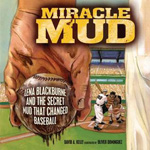 Did you know that before every baseball game, the umpire must inspect the official game balls to ensure “that they are properly rubbed,” so that the gloss is removed? In this picture book biography, readers will learn about Russell Aubrey “Lena” Blackburne, whose career as a baseball player and coach led him to invent baseball rubbing mud. During one of his fishing trips along the Delaware River, he found a mud hole and decided to experiment by rubbing a special consistency of mud on the baseballs. Today, Lena Blackburne’s baseball rubbing mud is still used before every game. A two-page author’s note provides additional background information to support the text. This picture book biography is ideal to read aloud to young readers to spark further inquiries about baseball but also to encourage creativity and innovation. You are never too young or too old to discover or invent a great idea.
Did you know that before every baseball game, the umpire must inspect the official game balls to ensure “that they are properly rubbed,” so that the gloss is removed? In this picture book biography, readers will learn about Russell Aubrey “Lena” Blackburne, whose career as a baseball player and coach led him to invent baseball rubbing mud. During one of his fishing trips along the Delaware River, he found a mud hole and decided to experiment by rubbing a special consistency of mud on the baseballs. Today, Lena Blackburne’s baseball rubbing mud is still used before every game. A two-page author’s note provides additional background information to support the text. This picture book biography is ideal to read aloud to young readers to spark further inquiries about baseball but also to encourage creativity and innovation. You are never too young or too old to discover or invent a great idea.
-Mary Napoli, Penn State Harrisburg
Meshon, Aaron. (2013). Take me out to the Yakyu. New York: Atheneum Books for Young Readers/Simon & Schuster.
 In this spirited picture book, a young boy compares and contrasts his favorite sport—baseball— played in the United States and in Japan. For example, in American, when his grandfather (pop pop) takes him to a baseball game, they drive to the stadium in a long, blue station-wagon. When he is in Japan, he and his ji ji take a red bus that turns into a train to watch yakyu at the dome. The bright and bold acrylic illustrations add charm and whimsy to this delightful read aloud. At the end of the book, there is a glossary of baseball and “other fun words.” Author/illustrator Meshon also includes detailed information about baseball in the U.S. and Japan. A perfect book to foster cultural awareness.
In this spirited picture book, a young boy compares and contrasts his favorite sport—baseball— played in the United States and in Japan. For example, in American, when his grandfather (pop pop) takes him to a baseball game, they drive to the stadium in a long, blue station-wagon. When he is in Japan, he and his ji ji take a red bus that turns into a train to watch yakyu at the dome. The bright and bold acrylic illustrations add charm and whimsy to this delightful read aloud. At the end of the book, there is a glossary of baseball and “other fun words.” Author/illustrator Meshon also includes detailed information about baseball in the U.S. and Japan. A perfect book to foster cultural awareness.
-Mary Napoli, Penn State Harrisburg
Hunter, Nick. (2014). The Winter Olympics. Chicago, IL: Heinemann Library.
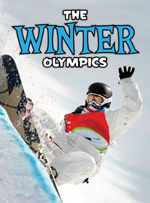 This informational text provides readers with brief summaries about the Olympics, including the history, symbols, winter sports, and controversial issues (i.e. performance enhancement drugs). Each page contains vivid photographs and various text features (i.e. bold font, text boxes) that capture important facts about the Winter Games. A world map, medal comparison table, glossary, resources/websites, and an index are included. Teachers might wish to partner this text with titles from the Winter Olympic Sports series available through Crabtree Publishing Company.
This informational text provides readers with brief summaries about the Olympics, including the history, symbols, winter sports, and controversial issues (i.e. performance enhancement drugs). Each page contains vivid photographs and various text features (i.e. bold font, text boxes) that capture important facts about the Winter Games. A world map, medal comparison table, glossary, resources/websites, and an index are included. Teachers might wish to partner this text with titles from the Winter Olympic Sports series available through Crabtree Publishing Company.
-Mary Napoli, Penn State Harrisburg
Coy, John. (2013). Hoop Genius: How a desperate teacher and a rowdy gym class invented basketball. Illus. by Joe Morse. Minneapolis, MN: Carolrhoda Books/Lerner Publishing Group.
 With college basketball’s forthcoming March Madness, students might be interested to learn about the origination of the game. In Hoop Genius, readers will learn about James Naismith, who accepted a teaching job in Springfield, MA in 1891. He took over teaching a group of students who had a reputation for being “rowdy” and led to the resignations of two other teachers. This did not stop James Naismith from trying to implement engaging activities for his group of active students. Though some of his initial attempts proved to be unsuccessful, he continued to persevere. He remembered playing a childhood game called “duck on a rock” and brilliantly adapted it to develop a new game. Naismith shared the rules of the game with his students and it became so popular that by 1936, basketball became an Olympic sport. Readers will draw inspiration from Naismith’s courage to discover a creative way to solve a discipline problem while making a positive impact on his students. Of special note: This book includes an author’s note, additional resource materials, and a reproduction of Naismith’s basketball rules.
With college basketball’s forthcoming March Madness, students might be interested to learn about the origination of the game. In Hoop Genius, readers will learn about James Naismith, who accepted a teaching job in Springfield, MA in 1891. He took over teaching a group of students who had a reputation for being “rowdy” and led to the resignations of two other teachers. This did not stop James Naismith from trying to implement engaging activities for his group of active students. Though some of his initial attempts proved to be unsuccessful, he continued to persevere. He remembered playing a childhood game called “duck on a rock” and brilliantly adapted it to develop a new game. Naismith shared the rules of the game with his students and it became so popular that by 1936, basketball became an Olympic sport. Readers will draw inspiration from Naismith’s courage to discover a creative way to solve a discipline problem while making a positive impact on his students. Of special note: This book includes an author’s note, additional resource materials, and a reproduction of Naismith’s basketball rules.
-Mary Napoli, Penn State Harrisburg
Grades 4-5
Borden, Louise. (2014). Baseball is… Illus. by Raúl Colón. New York: Margaret K. McElderry Books/Simon & Schuster.
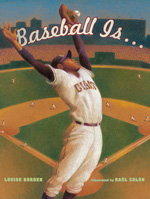 Borden shares her love of baseball by hitting a “home run” with her observations about baseball. Through beautifully written free-verse poetry, Borden brilliantly pens language to convey the tastes, smells, sights, and sounds of baseball. Each page begins with two words: Baseball is… followed by descriptive phrases to evoke imagery about the game. Colón’s beautiful illustrations capture the atmosphere and spirit of the game by celebrating its rich historical and social connection. The powerful visual and mental images will undoubtedly inspire writers to create their own class book about baseball or another sport.
Borden shares her love of baseball by hitting a “home run” with her observations about baseball. Through beautifully written free-verse poetry, Borden brilliantly pens language to convey the tastes, smells, sights, and sounds of baseball. Each page begins with two words: Baseball is… followed by descriptive phrases to evoke imagery about the game. Colón’s beautiful illustrations capture the atmosphere and spirit of the game by celebrating its rich historical and social connection. The powerful visual and mental images will undoubtedly inspire writers to create their own class book about baseball or another sport.
-Mary Napoli, Penn State Harrisburg
Moss, Marissa. (2013). Barbed wired baseball. Illus. by Yuko Shimizu. New York: Abrams Books for Young Readers.
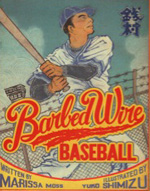 In this poignant nonfiction picture book, readers will learn about Kenichi “Zeni” Zenimura, known as the father of Japanese American baseball, and about his resiliency to persevere and achieve his dream despite difficult circumstances. As a young boy, Zeni became fascinated with baseball and didn’t let the comments about his short stature dissuade him from pursuing his dream of playing professional baseball. He had a successful career playing in the Fresno Nisei and Fresno Twilight Leagues. He was chosen to play with star members of the New York Yankees in an exhibition game and played alongside Babe Ruth and Lou Gehrig. In 1941, the bombing at Pearl Harbor changed the course of history. Zeni, his family, and thousands of Japanese American families who lived on the West Coast were sent to internment camps. Zeni wanted to bring some sense of normalcy to the difficult and desolate circumstances and decided to build a baseball field at the Gala River War Relocation Center in Arizona. Zeni, his two sons, and many others worked together to make the dream a reality. Soon, he organized games for people to play. Through Shimizu’s Japanese calligraphy brush and ink illustrations, the contrast between muted and dark colors convey the isolation and despair of families living at the camp. The baseball games and community brought a sense of hope during a very difficult time in history. The back matter contains an index, relevant websites, and resources to prompt further study. A recommended partner text is Baseball Saved Us (1993) by Ken Mochizuki, published by Lee & Low.
In this poignant nonfiction picture book, readers will learn about Kenichi “Zeni” Zenimura, known as the father of Japanese American baseball, and about his resiliency to persevere and achieve his dream despite difficult circumstances. As a young boy, Zeni became fascinated with baseball and didn’t let the comments about his short stature dissuade him from pursuing his dream of playing professional baseball. He had a successful career playing in the Fresno Nisei and Fresno Twilight Leagues. He was chosen to play with star members of the New York Yankees in an exhibition game and played alongside Babe Ruth and Lou Gehrig. In 1941, the bombing at Pearl Harbor changed the course of history. Zeni, his family, and thousands of Japanese American families who lived on the West Coast were sent to internment camps. Zeni wanted to bring some sense of normalcy to the difficult and desolate circumstances and decided to build a baseball field at the Gala River War Relocation Center in Arizona. Zeni, his two sons, and many others worked together to make the dream a reality. Soon, he organized games for people to play. Through Shimizu’s Japanese calligraphy brush and ink illustrations, the contrast between muted and dark colors convey the isolation and despair of families living at the camp. The baseball games and community brought a sense of hope during a very difficult time in history. The back matter contains an index, relevant websites, and resources to prompt further study. A recommended partner text is Baseball Saved Us (1993) by Ken Mochizuki, published by Lee & Low.
-Mary Napoli, Penn State Harrisburg
Tavares, Matt. (2013). Becoming Babe Ruth. Somerville, MA: Candlewick Press.
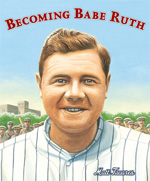 The appealing face of Babe Ruth on the cover of this book invites reader to get to know the famous baseball player. Throughout the book, the realistic watercolor illustrations bring Ruth’s personality to life. This books diverges from other picture book biographies of sports heroes, focusing quite a bit on Ruth’s childhood. The description of Ruth’s time at Saint Mary’s Industrial School for Boys enables readers to both sympathize with Ruth and understand the time period. The time period is further developed through recreated newspaper clippings and the subtlety of the art further creates a feel for the time. As Ruth’s career takes off, Tavares describes Ruth’s athletic achievements, his personality (“he does whatever he wants”), and the ways he used his fame to give back. Several pages feature up-close shots of Ruth’s face, always in an authentically joyful expression. What’s most impressive about this book is how the author balanced an engaging narrative with detailed information. The back matter contains an author’s note, a “stats” chart, and bibliography.
The appealing face of Babe Ruth on the cover of this book invites reader to get to know the famous baseball player. Throughout the book, the realistic watercolor illustrations bring Ruth’s personality to life. This books diverges from other picture book biographies of sports heroes, focusing quite a bit on Ruth’s childhood. The description of Ruth’s time at Saint Mary’s Industrial School for Boys enables readers to both sympathize with Ruth and understand the time period. The time period is further developed through recreated newspaper clippings and the subtlety of the art further creates a feel for the time. As Ruth’s career takes off, Tavares describes Ruth’s athletic achievements, his personality (“he does whatever he wants”), and the ways he used his fame to give back. Several pages feature up-close shots of Ruth’s face, always in an authentically joyful expression. What’s most impressive about this book is how the author balanced an engaging narrative with detailed information. The back matter contains an author’s note, a “stats” chart, and bibliography.
-Lesley Colabucci, Millersville University
Winter, Jonah. (2013). You never heard of Willie Mays?! Illus. by Terry Widener. New York: Schwartz & Wade Books/Random House.
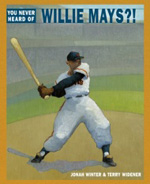 The action literally starts on the cover of this books—opening the book causes the bat to swing. The making of the “lenticular” cover is described on the copyright pages and the end pages contain replicas of baseball cards. Baseball fans will immediately be drawn to the embedded statistical and background information located in boxes on nearly every page. The source material is copious for a picture book biography of this nature: author’s note, glossary, about the author/illustrator, research notes on statistics, and quotes. This book is ideal for knowledge and passionate baseball fans, but will spark excitement among even those who do not know Mays or care for baseball. Winter’s text features dramatic flair and true reverences for the athlete while Widener’s art captures the time and place along with May’s determined spirit.
The action literally starts on the cover of this books—opening the book causes the bat to swing. The making of the “lenticular” cover is described on the copyright pages and the end pages contain replicas of baseball cards. Baseball fans will immediately be drawn to the embedded statistical and background information located in boxes on nearly every page. The source material is copious for a picture book biography of this nature: author’s note, glossary, about the author/illustrator, research notes on statistics, and quotes. This book is ideal for knowledge and passionate baseball fans, but will spark excitement among even those who do not know Mays or care for baseball. Winter’s text features dramatic flair and true reverences for the athlete while Widener’s art captures the time and place along with May’s determined spirit.
-Lesley Colabucci, Millersville University
Skead, R. (2013). Something to prove: The great Satchel Paige vs. rookie Joe Dimaggio. Illus. by Floyd Cooper. Minneapolis, MN: Carolrhoda Books.
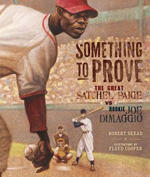 This book recounts a little known story in the history of baseball. Readers will venture into the worlds of the Negro Leagues as they learn about how Joe DiMaggio got his start in baseball. On the first page, readers learn that DiMaggio was “young skinny prospect” who needed to be bested. He’d be tested by a pitcher described as “the marvel of the country” who was not allowed to pay in the major leagues because of the color of his skin. Skead’s narrative texts and Cooper’s soft-toned illustrations, readers come to know and care about both players. The author takes readers inside the player’s heads and inside baseball strategy that has a play-by-play feel to it that keeps that action at the center of the story. An authors’ note is included with a brief bibliography. Astute readers will want to know more, not about this incident but also about both players.
This book recounts a little known story in the history of baseball. Readers will venture into the worlds of the Negro Leagues as they learn about how Joe DiMaggio got his start in baseball. On the first page, readers learn that DiMaggio was “young skinny prospect” who needed to be bested. He’d be tested by a pitcher described as “the marvel of the country” who was not allowed to pay in the major leagues because of the color of his skin. Skead’s narrative texts and Cooper’s soft-toned illustrations, readers come to know and care about both players. The author takes readers inside the player’s heads and inside baseball strategy that has a play-by-play feel to it that keeps that action at the center of the story. An authors’ note is included with a brief bibliography. Astute readers will want to know more, not about this incident but also about both players.
-Lesley Colabucci, Millersville University
Grades 6-8
Vernick, Audrey. (2014). Screaming at the ump. Boston, MA: Clarion Books/Houghton Mifflin Harcourt.
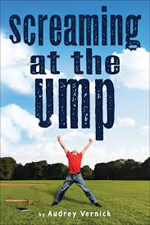 Aubrey Vernick hits a "grand slam" with her newest novel about Casey Snowden, a sixth grade aspiring writer. His father and grandfather own the third largest umpiring school in America and Casey has the enviable position to learn the inside angles of the sport. Baseball metaphors are woven throughout this middle grade novel. As Casey copes with his parents’ divorce, his estranged mother's desire to spend time with him, and whether or not to write his first school newspaper article about the annual “You Suck, Ump Day” event, he makes connections to baseball. As a prospective writer, Casey’s character compares the writing process with umpiring. For example, in his efforts to write an objective article, he states, "When writing an article, you had to show readers the facts, just the facts. It was like standing behind the plate. Umpire and reporter both have to be impartial and fair" (78). The school newspaper has never published an article written by a sixth grader, so Casey aims to be the first to accomplish this goal. He sets out to interview one of the umpire students and even though his first draft needs work, his determination and perseverance leads him to new discoveries about his writing and about his relationship with his mother. Baseball fans will appreciate the honesty and insights of this fast-paced coming-of-age novel.
Aubrey Vernick hits a "grand slam" with her newest novel about Casey Snowden, a sixth grade aspiring writer. His father and grandfather own the third largest umpiring school in America and Casey has the enviable position to learn the inside angles of the sport. Baseball metaphors are woven throughout this middle grade novel. As Casey copes with his parents’ divorce, his estranged mother's desire to spend time with him, and whether or not to write his first school newspaper article about the annual “You Suck, Ump Day” event, he makes connections to baseball. As a prospective writer, Casey’s character compares the writing process with umpiring. For example, in his efforts to write an objective article, he states, "When writing an article, you had to show readers the facts, just the facts. It was like standing behind the plate. Umpire and reporter both have to be impartial and fair" (78). The school newspaper has never published an article written by a sixth grader, so Casey aims to be the first to accomplish this goal. He sets out to interview one of the umpire students and even though his first draft needs work, his determination and perseverance leads him to new discoveries about his writing and about his relationship with his mother. Baseball fans will appreciate the honesty and insights of this fast-paced coming-of-age novel.
-Mary Napoli, Penn State Harrisburg
Goldsmith, Connie. (2014). Traumatic brain injury: From concussion to coma. Minneapolis, MN: Twenty-first century books/Lerner Publishing Group.
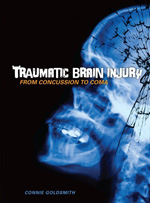 Goldsmith, a registered nurse, continues to share her knowledge about children’s health issues in her latest nonfiction book for children. Throughout this informative book, readers will learn interesting facts about traumatic brain injury (TBI) from what causes them to how they are diagnosed and treated. Did you know that there are approximately 1.7 million people diagnosed with TBI every year and that approximately 52,000 die from their injuries? Readers with an interest in sports will learn about information about sports related concussions, war injuries, motor vehicle accidents, and how individuals cope with traumatic brain injuries. Written in straightforward and accessible language, this nonfiction text is a must read for anyone interested in this topic. Charts, diagrams, and photographs add substance to the text.
Goldsmith, a registered nurse, continues to share her knowledge about children’s health issues in her latest nonfiction book for children. Throughout this informative book, readers will learn interesting facts about traumatic brain injury (TBI) from what causes them to how they are diagnosed and treated. Did you know that there are approximately 1.7 million people diagnosed with TBI every year and that approximately 52,000 die from their injuries? Readers with an interest in sports will learn about information about sports related concussions, war injuries, motor vehicle accidents, and how individuals cope with traumatic brain injuries. Written in straightforward and accessible language, this nonfiction text is a must read for anyone interested in this topic. Charts, diagrams, and photographs add substance to the text.
-Mary Napoli, Penn State Harrisburg
Grades 9-12
Dueker, C. (2013). Swagger. NY: Houghton Mifflin Harcourt.
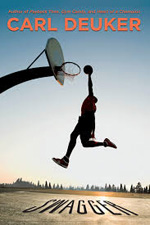 While Swagger is clearly a sports story, it is also highly character-driven with a believable plot. The contemporary feel of the story is strong as well. The protagonist, Jonas, is likable, and his struggles will be familiar to many readers. He’s a point guard whose game has gotten better and better, but is not getting the playing time he believes he deserves in his new school. He has college dreams despite his background and previous expectations of himself. Any sports fan will enjoy the on-the-court details which carry the book for quite a bit. Ultimately, the story takes a dramatic turn that tests Jonas and moves the novel into a different category because of the serious themes. Coach Hartwell’s sexual abuse of a fellow player is described in an appropriate and straightforward way that readers will be able to handle. Jonas’ struggles with understanding the truth, helping his friend, and questioning authority resonate with compassion and honesty. Kids in need will find resources for ending sexual abuse included on the last page.
While Swagger is clearly a sports story, it is also highly character-driven with a believable plot. The contemporary feel of the story is strong as well. The protagonist, Jonas, is likable, and his struggles will be familiar to many readers. He’s a point guard whose game has gotten better and better, but is not getting the playing time he believes he deserves in his new school. He has college dreams despite his background and previous expectations of himself. Any sports fan will enjoy the on-the-court details which carry the book for quite a bit. Ultimately, the story takes a dramatic turn that tests Jonas and moves the novel into a different category because of the serious themes. Coach Hartwell’s sexual abuse of a fellow player is described in an appropriate and straightforward way that readers will be able to handle. Jonas’ struggles with understanding the truth, helping his friend, and questioning authority resonate with compassion and honesty. Kids in need will find resources for ending sexual abuse included on the last page.
-Lesley Colabucci, Millersville University
Klass, David & Klass, Perri. (2013). Second impact: Making the hardest call of all. New York: Farrar Straus Giroux /Macmillan.
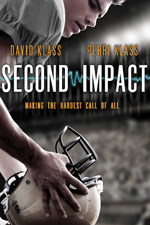 The unique format of this book will appeal to a variety of readers, not just those interested in sports novels. Jerry Downing is the star high school quarterback as well as the star of the book, and the story is told partly in his voice through blogs. His voice alternates with Carla Jenson’s, a savvy young journalist whose reports on sports injuries are unwanted by school administration. The relationship between Carla and Jerry is the heart of this story. Both characters have struggled with issues related to their experiences as high school athletes, including Carla’s knee injury and Jerry’s drunk driving incident. Together they capture (and begin to question) the role of sports in school and society at large. While Jerry has the more dramatic character arc and the big decision to make, their stories intertwine throughout in a way balances their story lines and keeps their friendship in play in important ways. One of the co-authors is a practicing physician and medical writer; some back matter with further research and information would have been advisable.
The unique format of this book will appeal to a variety of readers, not just those interested in sports novels. Jerry Downing is the star high school quarterback as well as the star of the book, and the story is told partly in his voice through blogs. His voice alternates with Carla Jenson’s, a savvy young journalist whose reports on sports injuries are unwanted by school administration. The relationship between Carla and Jerry is the heart of this story. Both characters have struggled with issues related to their experiences as high school athletes, including Carla’s knee injury and Jerry’s drunk driving incident. Together they capture (and begin to question) the role of sports in school and society at large. While Jerry has the more dramatic character arc and the big decision to make, their stories intertwine throughout in a way balances their story lines and keeps their friendship in play in important ways. One of the co-authors is a practicing physician and medical writer; some back matter with further research and information would have been advisable.
-Lesley Colabucci, Millersville University
Digital Connections: Websites and Apps
Olympics and the Winter Games:
Other Sports:
Apps:
These reviews are submitted by members of the International Reading Association's Children's Literature and Reading Special Interest Group (CL/R SIG) and are published weekly on Reading Today Online.
The CL/R SIG is accepting submissions to the fall 2014 edition of their journal, The Dragon Lode, through April 15, 2014. There is an open theme, and they invite manuscripts that explore contemporary issues and questions, genre study, literary theory, and research related to children's literature and reading. Manuscripts should be no longer than 20 double-spaced, typed pages. Use APA (6th edition) formatting. Author's name, affiliation, mailing address, telephone and fax numbers, and e-mail address should be on a separate cover page. Photos and illustrations should be sent as a separate jpeg file. Any reference to the author that would enable the reviewer to know the author's identity should not appear in the manuscript. Submit all manuscripts to: Dr. Ruth McKoy Lowery, Co-editor.
The International Reading Association partners with the National Council of Teachers of English and Verizon Thinkfinity to produce ReadWriteThink.org, a website devoted to providing literacy instruction and interactive resources for grades K–12.